PSYC1101 - Attachment Theory: Historical Development and Research
VerifiedAdded on 2023/04/23
|8
|1641
|475
Essay
AI Summary
This essay provides a comprehensive overview of attachment theory, tracing its historical development from the foundational work of John Bowlby and Mary Ainsworth to its influences from psychoanalytic thinkers like Sigmund and Anna Freud. It details the core concepts of attachment theory, including the four key attributes of attachment relationships (safe haven, secure base, proximity maintenance, and separation distress) and the four attachment styles identified by Ainsworth, Main, and Solomon (secure, ambivalent, avoidant, and disorganized). The essay also discusses Mary Ainsworth's 'Strange Situation' experiment and evaluates the theory, considering caregiver sensitivity and alternative theories based on temperament. The paper concludes by highlighting the significant impact of attachment theory on child psychology and its relevance to understanding mental illness rooted in childhood experiences. Desklib offers similar essays and study resources for students.
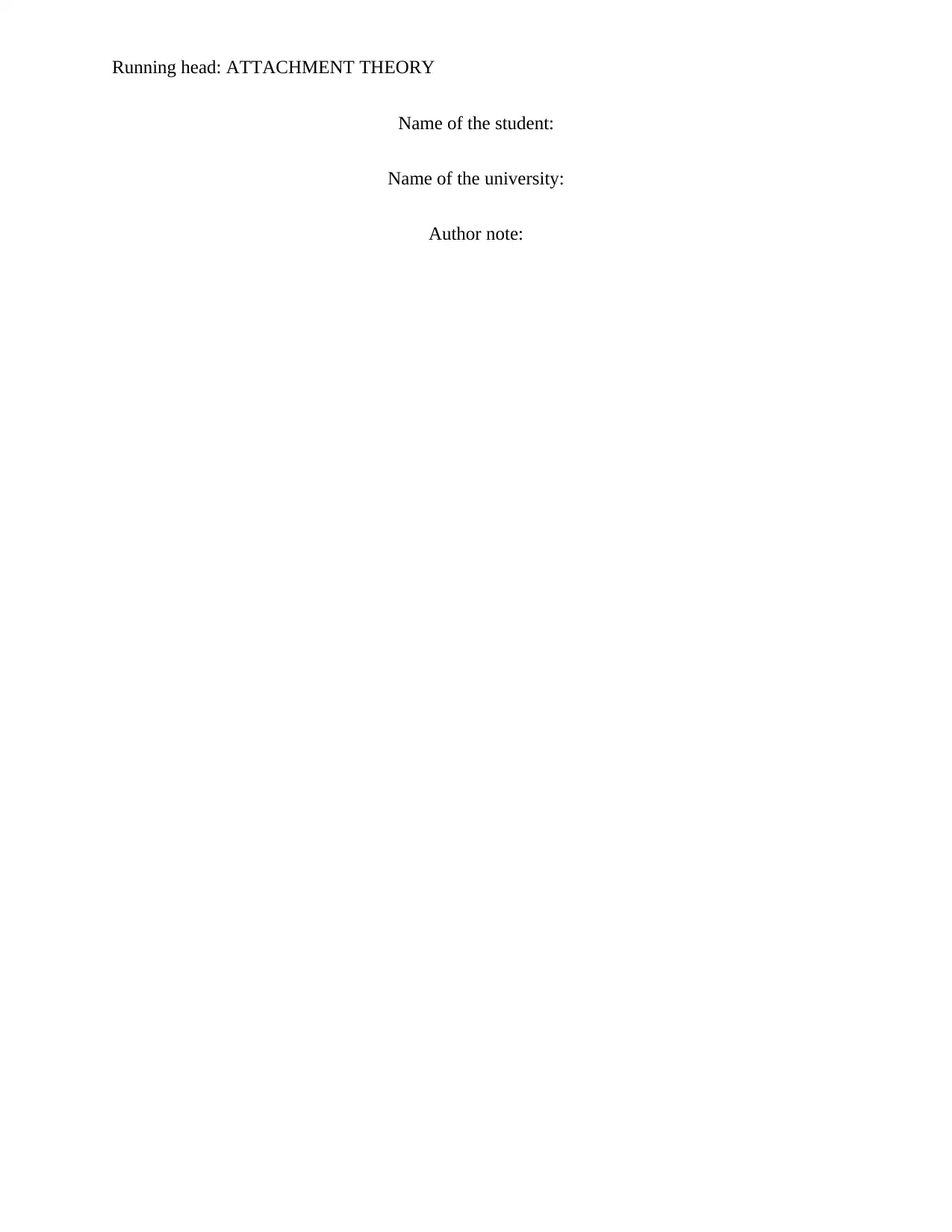
Running head: ATTACHMENT THEORY
Name of the student:
Name of the university:
Author note:
Name of the student:
Name of the university:
Author note:
Paraphrase This Document
Need a fresh take? Get an instant paraphrase of this document with our AI Paraphraser
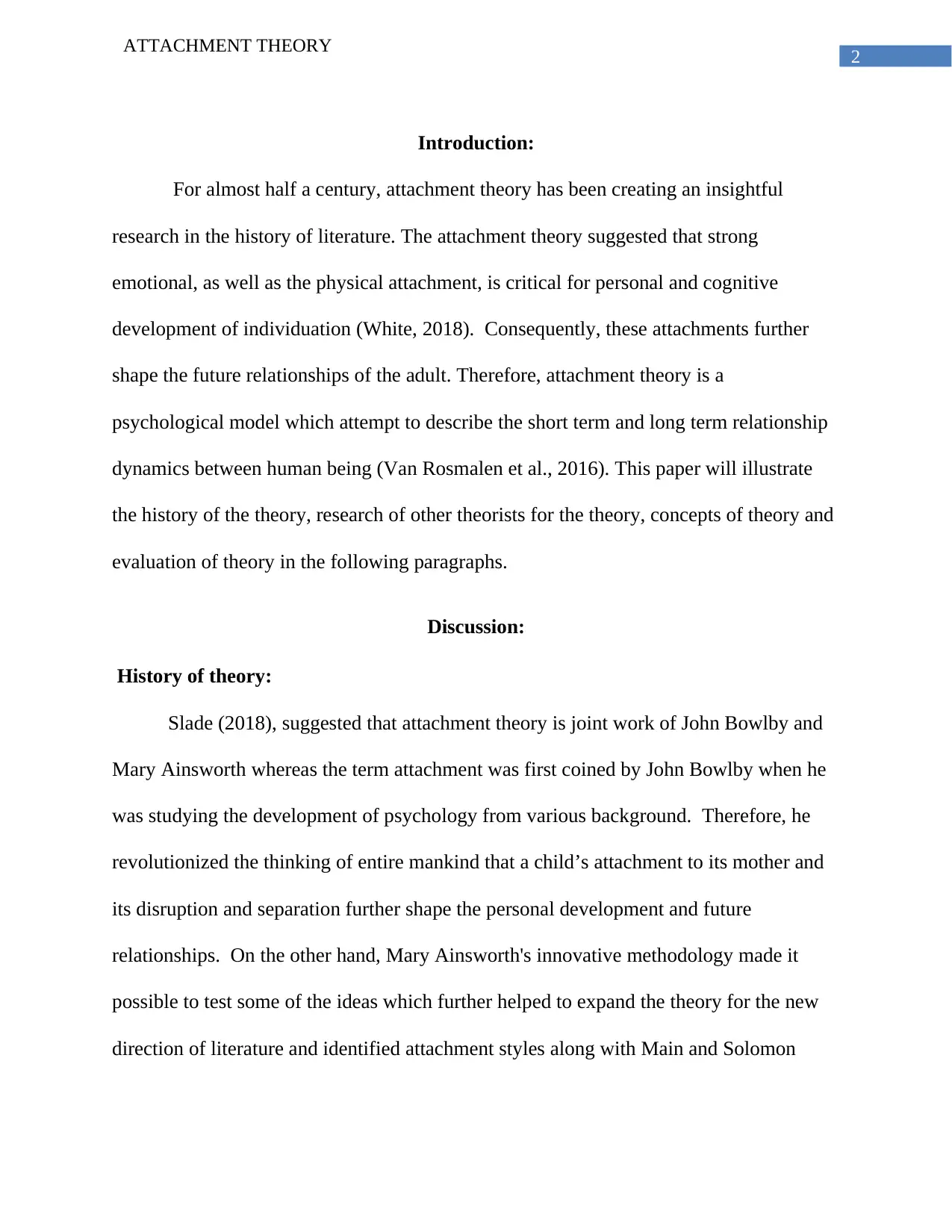
2
ATTACHMENT THEORY
Introduction:
For almost half a century, attachment theory has been creating an insightful
research in the history of literature. The attachment theory suggested that strong
emotional, as well as the physical attachment, is critical for personal and cognitive
development of individuation (White, 2018). Consequently, these attachments further
shape the future relationships of the adult. Therefore, attachment theory is a
psychological model which attempt to describe the short term and long term relationship
dynamics between human being (Van Rosmalen et al., 2016). This paper will illustrate
the history of the theory, research of other theorists for the theory, concepts of theory and
evaluation of theory in the following paragraphs.
Discussion:
History of theory:
Slade (2018), suggested that attachment theory is joint work of John Bowlby and
Mary Ainsworth whereas the term attachment was first coined by John Bowlby when he
was studying the development of psychology from various background. Therefore, he
revolutionized the thinking of entire mankind that a child’s attachment to its mother and
its disruption and separation further shape the personal development and future
relationships. On the other hand, Mary Ainsworth's innovative methodology made it
possible to test some of the ideas which further helped to expand the theory for the new
direction of literature and identified attachment styles along with Main and Solomon
ATTACHMENT THEORY
Introduction:
For almost half a century, attachment theory has been creating an insightful
research in the history of literature. The attachment theory suggested that strong
emotional, as well as the physical attachment, is critical for personal and cognitive
development of individuation (White, 2018). Consequently, these attachments further
shape the future relationships of the adult. Therefore, attachment theory is a
psychological model which attempt to describe the short term and long term relationship
dynamics between human being (Van Rosmalen et al., 2016). This paper will illustrate
the history of the theory, research of other theorists for the theory, concepts of theory and
evaluation of theory in the following paragraphs.
Discussion:
History of theory:
Slade (2018), suggested that attachment theory is joint work of John Bowlby and
Mary Ainsworth whereas the term attachment was first coined by John Bowlby when he
was studying the development of psychology from various background. Therefore, he
revolutionized the thinking of entire mankind that a child’s attachment to its mother and
its disruption and separation further shape the personal development and future
relationships. On the other hand, Mary Ainsworth's innovative methodology made it
possible to test some of the ideas which further helped to expand the theory for the new
direction of literature and identified attachment styles along with Main and Solomon
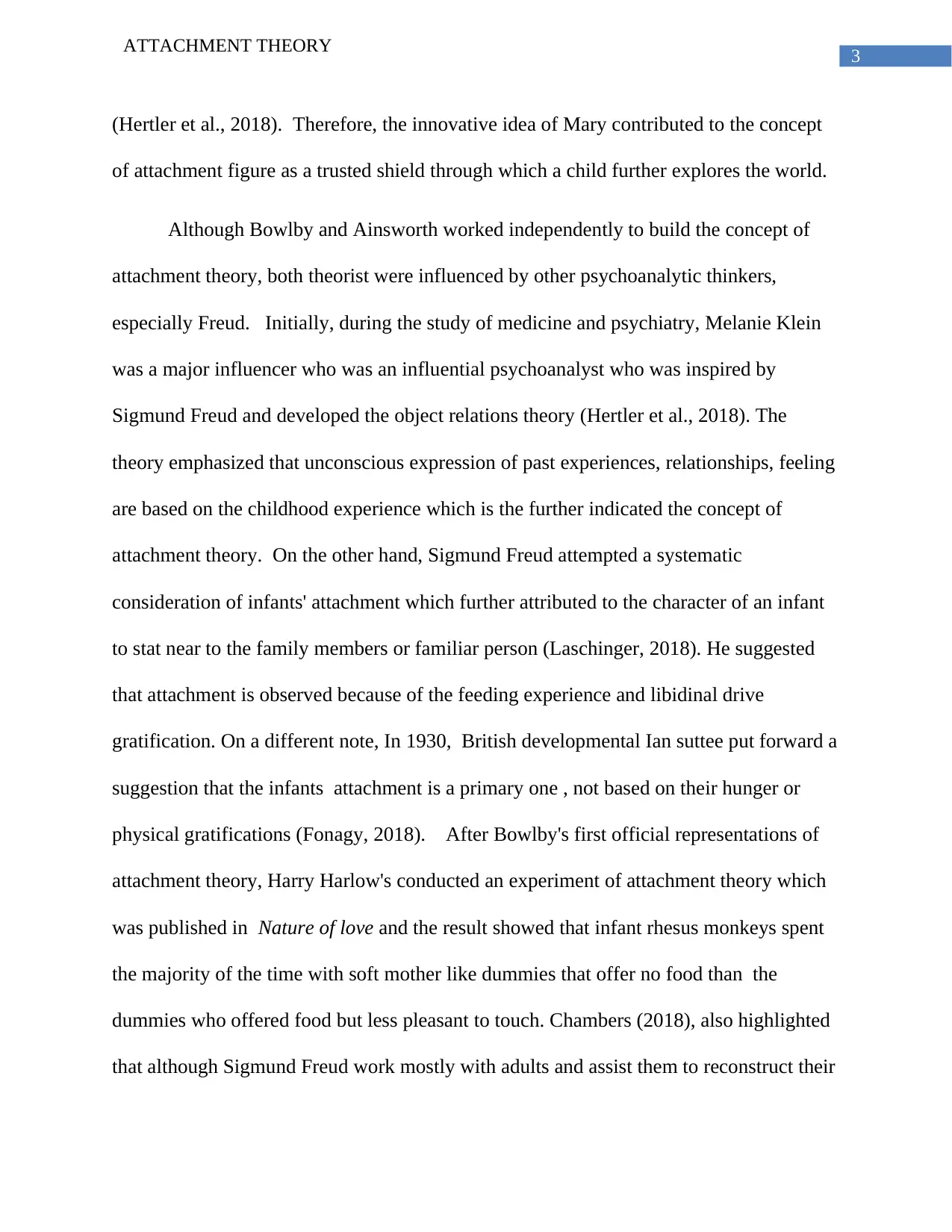
3
ATTACHMENT THEORY
(Hertler et al., 2018). Therefore, the innovative idea of Mary contributed to the concept
of attachment figure as a trusted shield through which a child further explores the world.
Although Bowlby and Ainsworth worked independently to build the concept of
attachment theory, both theorist were influenced by other psychoanalytic thinkers,
especially Freud. Initially, during the study of medicine and psychiatry, Melanie Klein
was a major influencer who was an influential psychoanalyst who was inspired by
Sigmund Freud and developed the object relations theory (Hertler et al., 2018). The
theory emphasized that unconscious expression of past experiences, relationships, feeling
are based on the childhood experience which is the further indicated the concept of
attachment theory. On the other hand, Sigmund Freud attempted a systematic
consideration of infants' attachment which further attributed to the character of an infant
to stat near to the family members or familiar person (Laschinger, 2018). He suggested
that attachment is observed because of the feeding experience and libidinal drive
gratification. On a different note, In 1930, British developmental Ian suttee put forward a
suggestion that the infants attachment is a primary one , not based on their hunger or
physical gratifications (Fonagy, 2018). After Bowlby's first official representations of
attachment theory, Harry Harlow's conducted an experiment of attachment theory which
was published in Nature of love and the result showed that infant rhesus monkeys spent
the majority of the time with soft mother like dummies that offer no food than the
dummies who offered food but less pleasant to touch. Chambers (2018), also highlighted
that although Sigmund Freud work mostly with adults and assist them to reconstruct their
ATTACHMENT THEORY
(Hertler et al., 2018). Therefore, the innovative idea of Mary contributed to the concept
of attachment figure as a trusted shield through which a child further explores the world.
Although Bowlby and Ainsworth worked independently to build the concept of
attachment theory, both theorist were influenced by other psychoanalytic thinkers,
especially Freud. Initially, during the study of medicine and psychiatry, Melanie Klein
was a major influencer who was an influential psychoanalyst who was inspired by
Sigmund Freud and developed the object relations theory (Hertler et al., 2018). The
theory emphasized that unconscious expression of past experiences, relationships, feeling
are based on the childhood experience which is the further indicated the concept of
attachment theory. On the other hand, Sigmund Freud attempted a systematic
consideration of infants' attachment which further attributed to the character of an infant
to stat near to the family members or familiar person (Laschinger, 2018). He suggested
that attachment is observed because of the feeding experience and libidinal drive
gratification. On a different note, In 1930, British developmental Ian suttee put forward a
suggestion that the infants attachment is a primary one , not based on their hunger or
physical gratifications (Fonagy, 2018). After Bowlby's first official representations of
attachment theory, Harry Harlow's conducted an experiment of attachment theory which
was published in Nature of love and the result showed that infant rhesus monkeys spent
the majority of the time with soft mother like dummies that offer no food than the
dummies who offered food but less pleasant to touch. Chambers (2018), also highlighted
that although Sigmund Freud work mostly with adults and assist them to reconstruct their
⊘ This is a preview!⊘
Do you want full access?
Subscribe today to unlock all pages.

Trusted by 1+ million students worldwide
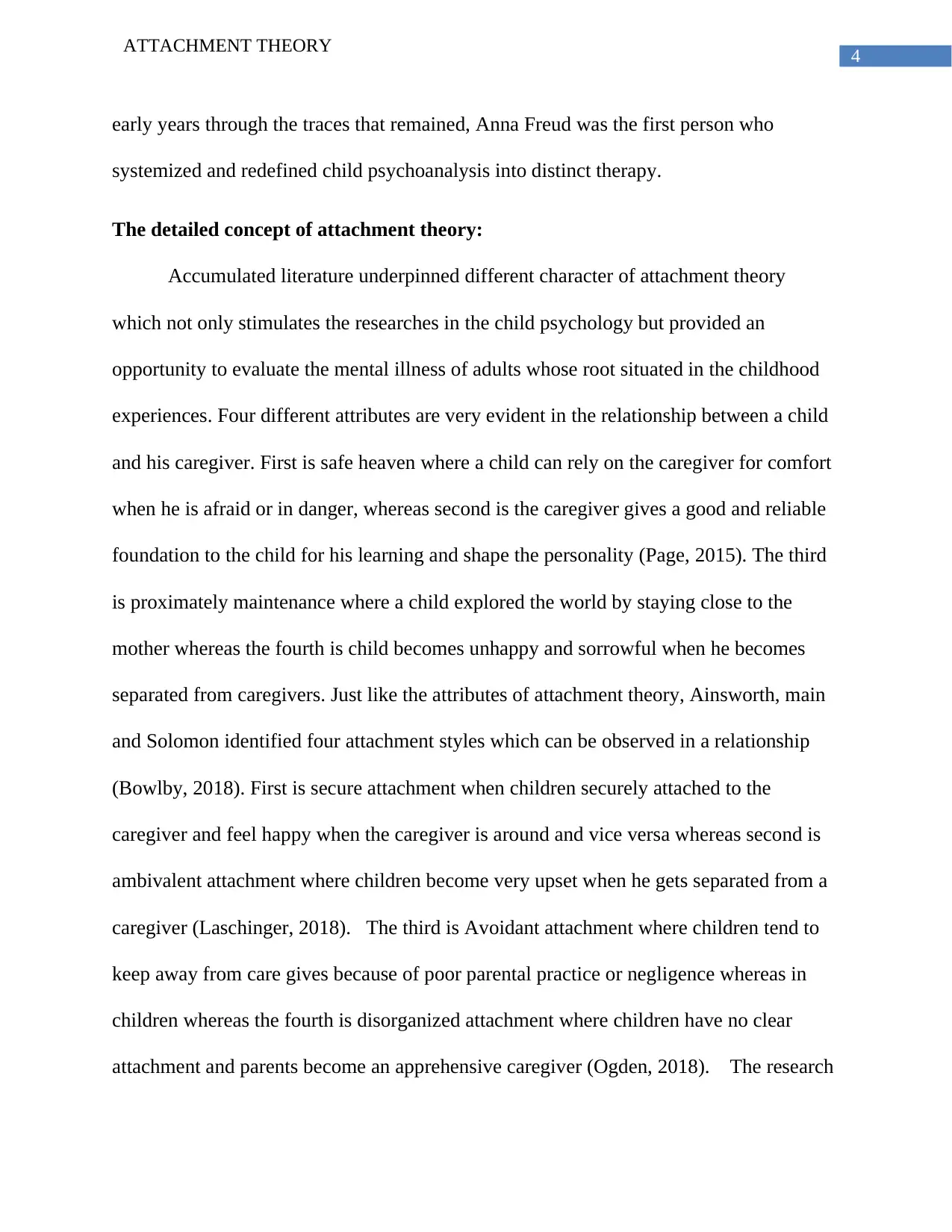
4
ATTACHMENT THEORY
early years through the traces that remained, Anna Freud was the first person who
systemized and redefined child psychoanalysis into distinct therapy.
The detailed concept of attachment theory:
Accumulated literature underpinned different character of attachment theory
which not only stimulates the researches in the child psychology but provided an
opportunity to evaluate the mental illness of adults whose root situated in the childhood
experiences. Four different attributes are very evident in the relationship between a child
and his caregiver. First is safe heaven where a child can rely on the caregiver for comfort
when he is afraid or in danger, whereas second is the caregiver gives a good and reliable
foundation to the child for his learning and shape the personality (Page, 2015). The third
is proximately maintenance where a child explored the world by staying close to the
mother whereas the fourth is child becomes unhappy and sorrowful when he becomes
separated from caregivers. Just like the attributes of attachment theory, Ainsworth, main
and Solomon identified four attachment styles which can be observed in a relationship
(Bowlby, 2018). First is secure attachment when children securely attached to the
caregiver and feel happy when the caregiver is around and vice versa whereas second is
ambivalent attachment where children become very upset when he gets separated from a
caregiver (Laschinger, 2018). The third is Avoidant attachment where children tend to
keep away from care gives because of poor parental practice or negligence whereas in
children whereas the fourth is disorganized attachment where children have no clear
attachment and parents become an apprehensive caregiver (Ogden, 2018). The research
ATTACHMENT THEORY
early years through the traces that remained, Anna Freud was the first person who
systemized and redefined child psychoanalysis into distinct therapy.
The detailed concept of attachment theory:
Accumulated literature underpinned different character of attachment theory
which not only stimulates the researches in the child psychology but provided an
opportunity to evaluate the mental illness of adults whose root situated in the childhood
experiences. Four different attributes are very evident in the relationship between a child
and his caregiver. First is safe heaven where a child can rely on the caregiver for comfort
when he is afraid or in danger, whereas second is the caregiver gives a good and reliable
foundation to the child for his learning and shape the personality (Page, 2015). The third
is proximately maintenance where a child explored the world by staying close to the
mother whereas the fourth is child becomes unhappy and sorrowful when he becomes
separated from caregivers. Just like the attributes of attachment theory, Ainsworth, main
and Solomon identified four attachment styles which can be observed in a relationship
(Bowlby, 2018). First is secure attachment when children securely attached to the
caregiver and feel happy when the caregiver is around and vice versa whereas second is
ambivalent attachment where children become very upset when he gets separated from a
caregiver (Laschinger, 2018). The third is Avoidant attachment where children tend to
keep away from care gives because of poor parental practice or negligence whereas in
children whereas the fourth is disorganized attachment where children have no clear
attachment and parents become an apprehensive caregiver (Ogden, 2018). The research
Paraphrase This Document
Need a fresh take? Get an instant paraphrase of this document with our AI Paraphraser
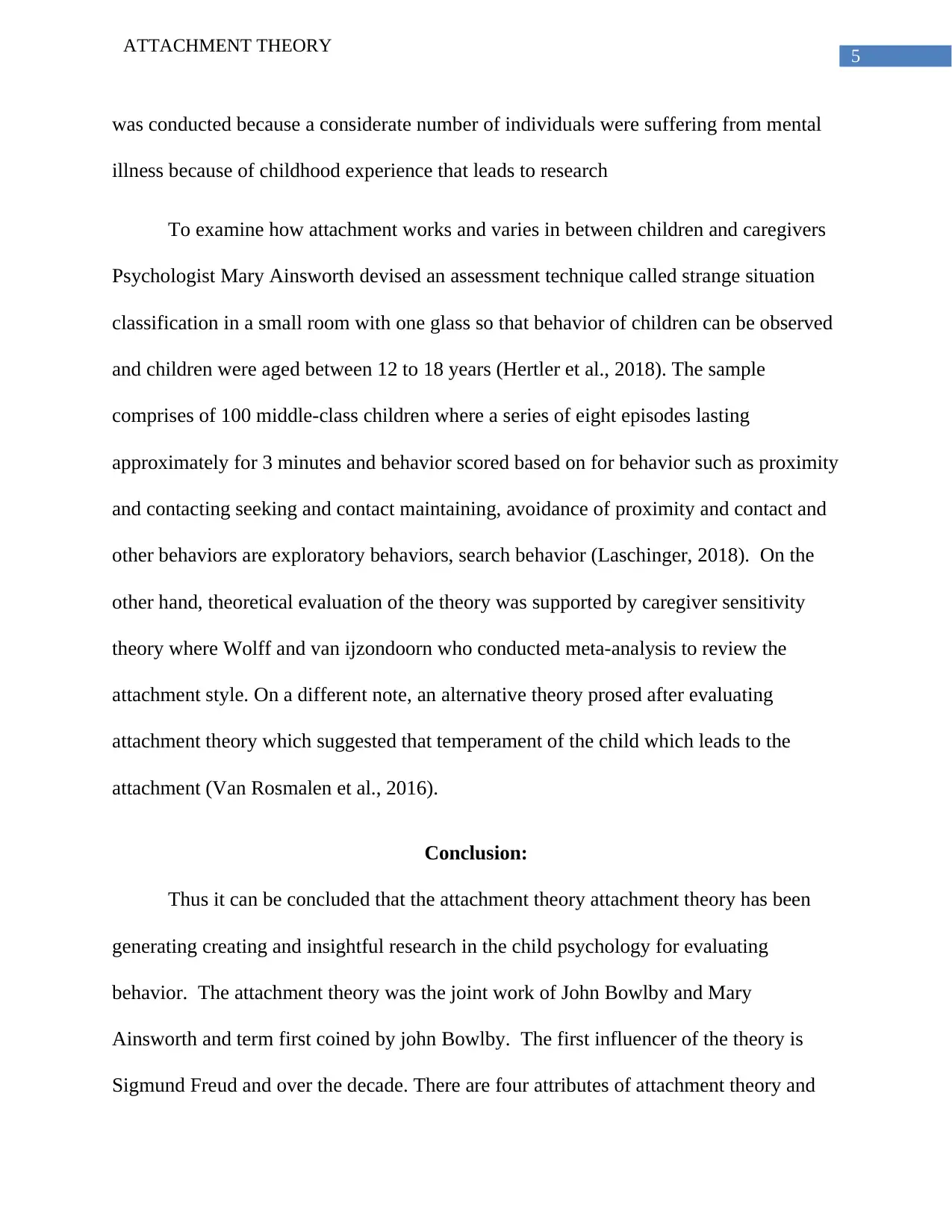
5
ATTACHMENT THEORY
was conducted because a considerate number of individuals were suffering from mental
illness because of childhood experience that leads to research
To examine how attachment works and varies in between children and caregivers
Psychologist Mary Ainsworth devised an assessment technique called strange situation
classification in a small room with one glass so that behavior of children can be observed
and children were aged between 12 to 18 years (Hertler et al., 2018). The sample
comprises of 100 middle-class children where a series of eight episodes lasting
approximately for 3 minutes and behavior scored based on for behavior such as proximity
and contacting seeking and contact maintaining, avoidance of proximity and contact and
other behaviors are exploratory behaviors, search behavior (Laschinger, 2018). On the
other hand, theoretical evaluation of the theory was supported by caregiver sensitivity
theory where Wolff and van ijzondoorn who conducted meta-analysis to review the
attachment style. On a different note, an alternative theory prosed after evaluating
attachment theory which suggested that temperament of the child which leads to the
attachment (Van Rosmalen et al., 2016).
Conclusion:
Thus it can be concluded that the attachment theory attachment theory has been
generating creating and insightful research in the child psychology for evaluating
behavior. The attachment theory was the joint work of John Bowlby and Mary
Ainsworth and term first coined by john Bowlby. The first influencer of the theory is
Sigmund Freud and over the decade. There are four attributes of attachment theory and
ATTACHMENT THEORY
was conducted because a considerate number of individuals were suffering from mental
illness because of childhood experience that leads to research
To examine how attachment works and varies in between children and caregivers
Psychologist Mary Ainsworth devised an assessment technique called strange situation
classification in a small room with one glass so that behavior of children can be observed
and children were aged between 12 to 18 years (Hertler et al., 2018). The sample
comprises of 100 middle-class children where a series of eight episodes lasting
approximately for 3 minutes and behavior scored based on for behavior such as proximity
and contacting seeking and contact maintaining, avoidance of proximity and contact and
other behaviors are exploratory behaviors, search behavior (Laschinger, 2018). On the
other hand, theoretical evaluation of the theory was supported by caregiver sensitivity
theory where Wolff and van ijzondoorn who conducted meta-analysis to review the
attachment style. On a different note, an alternative theory prosed after evaluating
attachment theory which suggested that temperament of the child which leads to the
attachment (Van Rosmalen et al., 2016).
Conclusion:
Thus it can be concluded that the attachment theory attachment theory has been
generating creating and insightful research in the child psychology for evaluating
behavior. The attachment theory was the joint work of John Bowlby and Mary
Ainsworth and term first coined by john Bowlby. The first influencer of the theory is
Sigmund Freud and over the decade. There are four attributes of attachment theory and
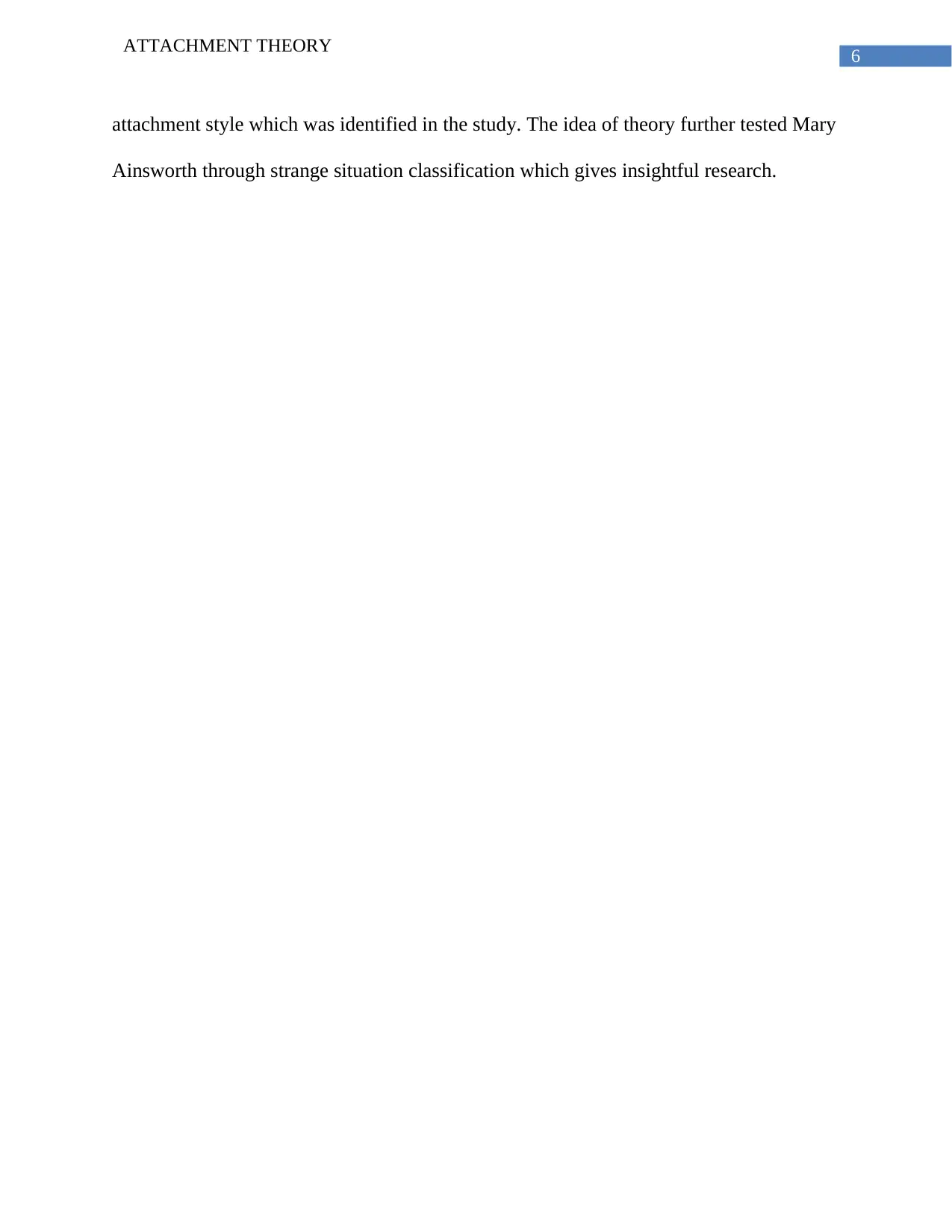
6
ATTACHMENT THEORY
attachment style which was identified in the study. The idea of theory further tested Mary
Ainsworth through strange situation classification which gives insightful research.
ATTACHMENT THEORY
attachment style which was identified in the study. The idea of theory further tested Mary
Ainsworth through strange situation classification which gives insightful research.
⊘ This is a preview!⊘
Do you want full access?
Subscribe today to unlock all pages.

Trusted by 1+ million students worldwide
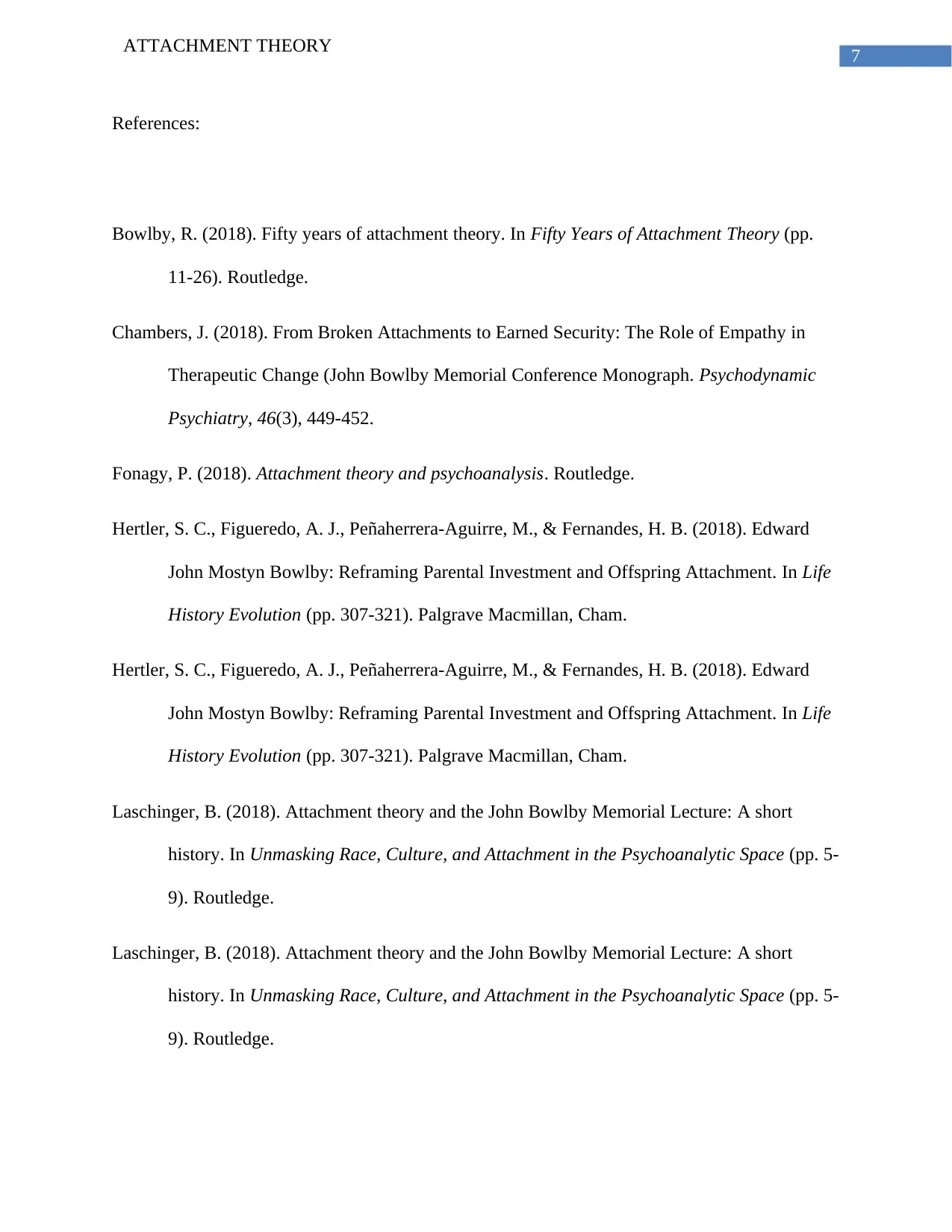
7
ATTACHMENT THEORY
References:
Bowlby, R. (2018). Fifty years of attachment theory. In Fifty Years of Attachment Theory (pp.
11-26). Routledge.
Chambers, J. (2018). From Broken Attachments to Earned Security: The Role of Empathy in
Therapeutic Change (John Bowlby Memorial Conference Monograph. Psychodynamic
Psychiatry, 46(3), 449-452.
Fonagy, P. (2018). Attachment theory and psychoanalysis. Routledge.
Hertler, S. C., Figueredo, A. J., Peñaherrera-Aguirre, M., & Fernandes, H. B. (2018). Edward
John Mostyn Bowlby: Reframing Parental Investment and Offspring Attachment. In Life
History Evolution (pp. 307-321). Palgrave Macmillan, Cham.
Hertler, S. C., Figueredo, A. J., Peñaherrera-Aguirre, M., & Fernandes, H. B. (2018). Edward
John Mostyn Bowlby: Reframing Parental Investment and Offspring Attachment. In Life
History Evolution (pp. 307-321). Palgrave Macmillan, Cham.
Laschinger, B. (2018). Attachment theory and the John Bowlby Memorial Lecture: A short
history. In Unmasking Race, Culture, and Attachment in the Psychoanalytic Space (pp. 5-
9). Routledge.
Laschinger, B. (2018). Attachment theory and the John Bowlby Memorial Lecture: A short
history. In Unmasking Race, Culture, and Attachment in the Psychoanalytic Space (pp. 5-
9). Routledge.
ATTACHMENT THEORY
References:
Bowlby, R. (2018). Fifty years of attachment theory. In Fifty Years of Attachment Theory (pp.
11-26). Routledge.
Chambers, J. (2018). From Broken Attachments to Earned Security: The Role of Empathy in
Therapeutic Change (John Bowlby Memorial Conference Monograph. Psychodynamic
Psychiatry, 46(3), 449-452.
Fonagy, P. (2018). Attachment theory and psychoanalysis. Routledge.
Hertler, S. C., Figueredo, A. J., Peñaherrera-Aguirre, M., & Fernandes, H. B. (2018). Edward
John Mostyn Bowlby: Reframing Parental Investment and Offspring Attachment. In Life
History Evolution (pp. 307-321). Palgrave Macmillan, Cham.
Hertler, S. C., Figueredo, A. J., Peñaherrera-Aguirre, M., & Fernandes, H. B. (2018). Edward
John Mostyn Bowlby: Reframing Parental Investment and Offspring Attachment. In Life
History Evolution (pp. 307-321). Palgrave Macmillan, Cham.
Laschinger, B. (2018). Attachment theory and the John Bowlby Memorial Lecture: A short
history. In Unmasking Race, Culture, and Attachment in the Psychoanalytic Space (pp. 5-
9). Routledge.
Laschinger, B. (2018). Attachment theory and the John Bowlby Memorial Lecture: A short
history. In Unmasking Race, Culture, and Attachment in the Psychoanalytic Space (pp. 5-
9). Routledge.
Paraphrase This Document
Need a fresh take? Get an instant paraphrase of this document with our AI Paraphraser
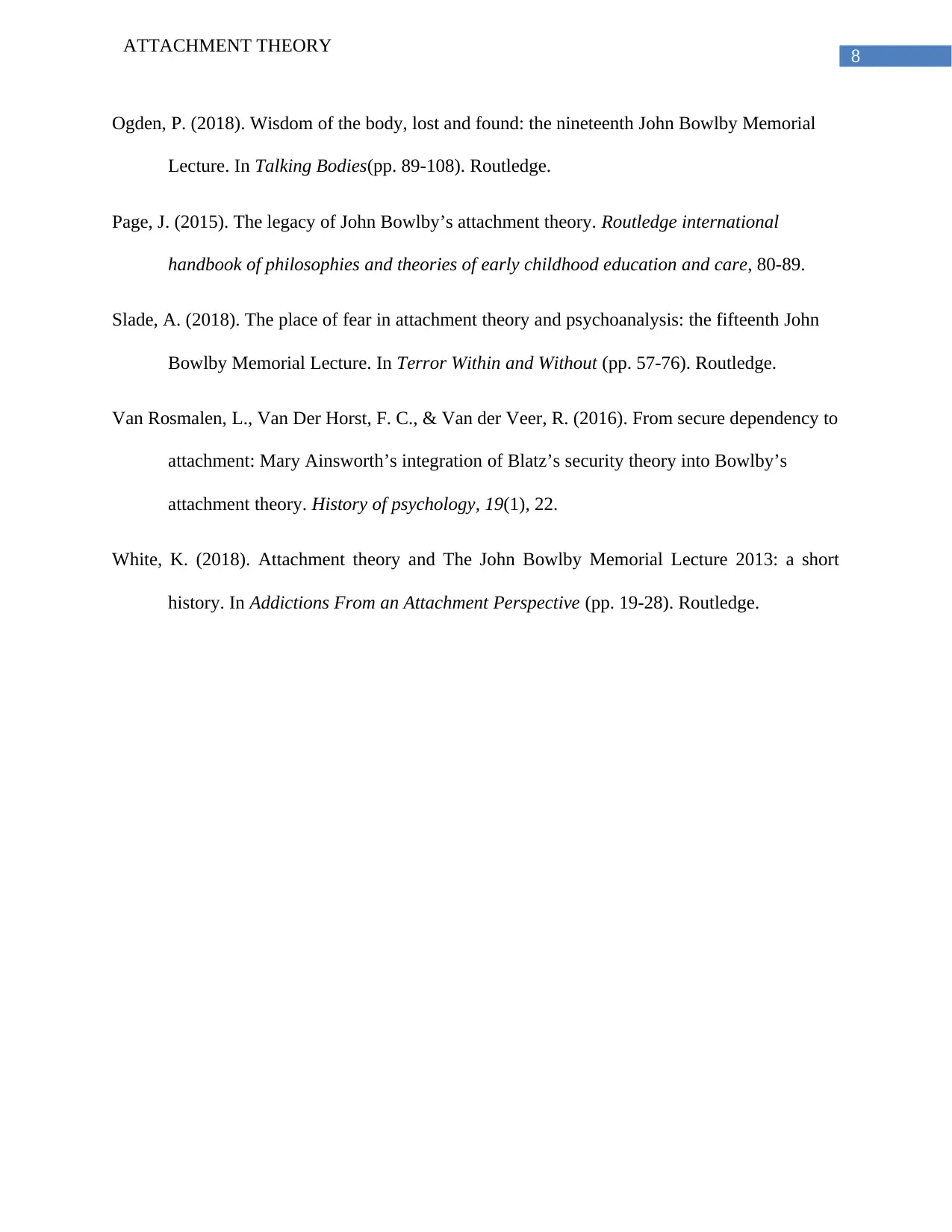
8
ATTACHMENT THEORY
Ogden, P. (2018). Wisdom of the body, lost and found: the nineteenth John Bowlby Memorial
Lecture. In Talking Bodies(pp. 89-108). Routledge.
Page, J. (2015). The legacy of John Bowlby’s attachment theory. Routledge international
handbook of philosophies and theories of early childhood education and care, 80-89.
Slade, A. (2018). The place of fear in attachment theory and psychoanalysis: the fifteenth John
Bowlby Memorial Lecture. In Terror Within and Without (pp. 57-76). Routledge.
Van Rosmalen, L., Van Der Horst, F. C., & Van der Veer, R. (2016). From secure dependency to
attachment: Mary Ainsworth’s integration of Blatz’s security theory into Bowlby’s
attachment theory. History of psychology, 19(1), 22.
White, K. (2018). Attachment theory and The John Bowlby Memorial Lecture 2013: a short
history. In Addictions From an Attachment Perspective (pp. 19-28). Routledge.
ATTACHMENT THEORY
Ogden, P. (2018). Wisdom of the body, lost and found: the nineteenth John Bowlby Memorial
Lecture. In Talking Bodies(pp. 89-108). Routledge.
Page, J. (2015). The legacy of John Bowlby’s attachment theory. Routledge international
handbook of philosophies and theories of early childhood education and care, 80-89.
Slade, A. (2018). The place of fear in attachment theory and psychoanalysis: the fifteenth John
Bowlby Memorial Lecture. In Terror Within and Without (pp. 57-76). Routledge.
Van Rosmalen, L., Van Der Horst, F. C., & Van der Veer, R. (2016). From secure dependency to
attachment: Mary Ainsworth’s integration of Blatz’s security theory into Bowlby’s
attachment theory. History of psychology, 19(1), 22.
White, K. (2018). Attachment theory and The John Bowlby Memorial Lecture 2013: a short
history. In Addictions From an Attachment Perspective (pp. 19-28). Routledge.
1 out of 8
Related Documents
Your All-in-One AI-Powered Toolkit for Academic Success.
+13062052269
info@desklib.com
Available 24*7 on WhatsApp / Email
![[object Object]](/_next/static/media/star-bottom.7253800d.svg)
Unlock your academic potential
Copyright © 2020–2025 A2Z Services. All Rights Reserved. Developed and managed by ZUCOL.





